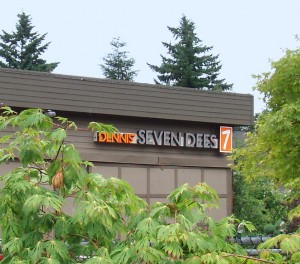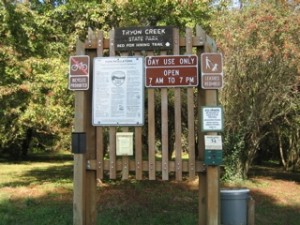 Though you wouldn’t know it today to look out my window (cloudy & some drizzle), it is summer, sunbeams have been out in force, and temps have been shooting up along with the plants in our yards and gardens. Some of this has to do with the heat, and some has to do with the fact that we are watering things while there is heat. At this time of year, and especially during a recession, we all need a refresher course on watering, and Lake Oswego is only too happy to oblige!
Though you wouldn’t know it today to look out my window (cloudy & some drizzle), it is summer, sunbeams have been out in force, and temps have been shooting up along with the plants in our yards and gardens. Some of this has to do with the heat, and some has to do with the fact that we are watering things while there is heat. At this time of year, and especially during a recession, we all need a refresher course on watering, and Lake Oswego is only too happy to oblige!
 Water conservation experts from the Regional Water Providers Consortium (RWPC) are visiting Lake Oswego for a session with local residents where they plan to hand out free water gauges and lots of good tips for water-efficient landscaping and maintenance. This event will be held this Saturday, June 13th, at Dennis’ 7 Dees Garden Center, 1090 McVey Ave., from 10 AM to 2 PM.
Water conservation experts from the Regional Water Providers Consortium (RWPC) are visiting Lake Oswego for a session with local residents where they plan to hand out free water gauges and lots of good tips for water-efficient landscaping and maintenance. This event will be held this Saturday, June 13th, at Dennis’ 7 Dees Garden Center, 1090 McVey Ave., from 10 AM to 2 PM.
The Consortium has an amazing website that reminds me how much there  is to learn. I remember thinking, when I was much younger and of course knew much more than I do today (or thought I did), that being a native of Southern California (Hey… No ribbing… I’ve been here since 1978!) , I had a very hard time believing that there was truly any need to conserve water in Oregon… I mean come on! With all the rainfall, the huge river running through town, the snowy mountain peaks dribbling water through Portland all year long… How was I supposed to believe that we actually needed to pay much attention at all to water consumption? Well, in recent years we have all learned how integral our activities are to maintaining the living environment we so cherish and want to hand to our children. There really are limits to what nature can provide us in our current numbers & given the constraints of our infrastructure. Then, there is that money thing… Practical tips for saving money while saving water? I’m all ears!
is to learn. I remember thinking, when I was much younger and of course knew much more than I do today (or thought I did), that being a native of Southern California (Hey… No ribbing… I’ve been here since 1978!) , I had a very hard time believing that there was truly any need to conserve water in Oregon… I mean come on! With all the rainfall, the huge river running through town, the snowy mountain peaks dribbling water through Portland all year long… How was I supposed to believe that we actually needed to pay much attention at all to water consumption? Well, in recent years we have all learned how integral our activities are to maintaining the living environment we so cherish and want to hand to our children. There really are limits to what nature can provide us in our current numbers & given the constraints of our infrastructure. Then, there is that money thing… Practical tips for saving money while saving water? I’m all ears!
Among the vast array of uselful material to be found at the RWPC site are the following good pieces of information:
- Use Mulch! It is important to know what kind to use however: –Organic Mulches (aged manure, bark chips, wood chips) and compost material will significantly decrease the amount of water you will need for plant health. Specifically, the addition of as little as 5% organic material can quadruple your soil’s ability to store water, decreasing the watering needed. – Inorganic mulches like stones, concrete and gravel can be great for creating landscape patterns etc., but also “re-radiate” the sun’s heat and cause an increase in the amount of water needed to care for surrounding plants.
- Create Watering Zones – These would be areas of your property wherein similar types of plants reside hopefully having similar watering requirements. (Lawn areas, rose garden, annual garden, perennial garden etc) This way you avoid the “one system fits all” mentality and the over-watering that results for some garden areas.
- Adjust Watering Schedules Frequently – As the temperatures shift during the summer, you will want to adjust your watering schedules accordingly.
- Managed Stress in the Landscape – There are all sorts of seemingly complicated formulas to help you determine how much to water a lawn at any given temperature. The RWPC site simplifies this information and helps you understand the “Stressing” concept, which basically means watering as little as possible forcing lawns to use their natural coping mechanisms and give you a green lawn all summer without the heavy over-watering that is so prevalent.
- Water Plants Thoroughly but Infrequently – This causes roots to go deeper and therefore be more drought resistant/require less watering.
- Water When Temps are Cooler – Preferably before 10:00AM or after 6:00PM.
- Use Drip Irrigation Where Possible – Large water droplets close to the ground are much more efficient than sprinkler systems which lose a lot of water to evaporation.
- Don’t Water in the Rain – Use rain sensors and gauges to eliminate unnecessary automatic watering when it is raining.


 There is such a panoply of amenities in Lake Oswego that Dianne and I have been talking about incorporating profiles of local favorites from time to time. I thought I’d begin with a very special person who I would be lost without… my local “dog-whisperer”, Valerie Pulley.
There is such a panoply of amenities in Lake Oswego that Dianne and I have been talking about incorporating profiles of local favorites from time to time. I thought I’d begin with a very special person who I would be lost without… my local “dog-whisperer”, Valerie Pulley. seems it has been the subject of pets, and dogs in particular. We all know what a Portuguese Water Dog is now, thanks to “Beau” at the White House. I know our own friend & blogging cohort, Ron Ares, wrote a post most recently about his own dog, Nyree (left), adopted by the Ares family to save her from becoming a casualty of foreclosure. I’ve seen pieces on local and national news about the amazing number of dogs that have been abandoned or taken to shelters as fallout from the current economy, and it is heartbreaking to consider.
seems it has been the subject of pets, and dogs in particular. We all know what a Portuguese Water Dog is now, thanks to “Beau” at the White House. I know our own friend & blogging cohort, Ron Ares, wrote a post most recently about his own dog, Nyree (left), adopted by the Ares family to save her from becoming a casualty of foreclosure. I’ve seen pieces on local and national news about the amazing number of dogs that have been abandoned or taken to shelters as fallout from the current economy, and it is heartbreaking to consider. Staffordshire Terrier, Fedore, is her pride & joy, I’ve been taking my crazy black Standard Schnauzer, Kato (right) , to Valerie for years, and she is the only one who can calm him down enough to let his toenails be clipped. Turns out others have noticed this talent as well, and dog owners from far and wide bring their “hard to handle” pets to Valerie for tender loving care. Valerie mentions that “Some dogs have been kicked out of every grooming salon in Portland for biting, scratching, and generally squirming and freaking out. They bring them to me because I am the only one they’ve found to be able to handle them.” I
Staffordshire Terrier, Fedore, is her pride & joy, I’ve been taking my crazy black Standard Schnauzer, Kato (right) , to Valerie for years, and she is the only one who can calm him down enough to let his toenails be clipped. Turns out others have noticed this talent as well, and dog owners from far and wide bring their “hard to handle” pets to Valerie for tender loving care. Valerie mentions that “Some dogs have been kicked out of every grooming salon in Portland for biting, scratching, and generally squirming and freaking out. They bring them to me because I am the only one they’ve found to be able to handle them.” I  ask her why she thinks this is, and she says “I’m just not afraid of them, and I care about them.” She has been working in the Lake Oswego area for around 12 years now, spending some of her career at the Lake Oswego Dog Shoppe, and now is working for
ask her why she thinks this is, and she says “I’m just not afraid of them, and I care about them.” She has been working in the Lake Oswego area for around 12 years now, spending some of her career at the Lake Oswego Dog Shoppe, and now is working for  When looking for a new home and desiring easy care and potential community amenities such as pool, larger grounds, meeting space etc (without the responsibility of upkeep), most people will consider either a condo or a town home. Most also aren’t necessarily familiar with several relative factors important to the selection process, so I thought I’d highlight just a few for you here.
When looking for a new home and desiring easy care and potential community amenities such as pool, larger grounds, meeting space etc (without the responsibility of upkeep), most people will consider either a condo or a town home. Most also aren’t necessarily familiar with several relative factors important to the selection process, so I thought I’d highlight just a few for you here. Two weeks ago I posted information about Tryon Creek State Park and mentioned that there are two neighborhoods in Lake Oswego with trail access into the Park. One is First Addition and the other is Forest Highlands. In our archives you’ll find a neighborhood profile for
Two weeks ago I posted information about Tryon Creek State Park and mentioned that there are two neighborhoods in Lake Oswego with trail access into the Park. One is First Addition and the other is Forest Highlands. In our archives you’ll find a neighborhood profile for  There is, in fact, a beautiful condominium development in Forest Highlands, Red Fox Hills. The condominiums are all townhouse style: they are attached on the sides but do not have neighbors above or below. Amenities include expansive lawns and gardens as well as a pool and a recreation facility. Current pricing ranges from $226,000 for a 2 bedroom, bath and a half unit, to $399,000 for a 3 bedroom, 2 full bath unit. All units have garages.
There is, in fact, a beautiful condominium development in Forest Highlands, Red Fox Hills. The condominiums are all townhouse style: they are attached on the sides but do not have neighbors above or below. Amenities include expansive lawns and gardens as well as a pool and a recreation facility. Current pricing ranges from $226,000 for a 2 bedroom, bath and a half unit, to $399,000 for a 3 bedroom, 2 full bath unit. All units have garages. And then there is that wonderful proximity to Tryon Creek Park. The entrance from Forest Highlands is at the turn about at the end of Boca Ratan Dr (right behind Red Fox Hills).
And then there is that wonderful proximity to Tryon Creek Park. The entrance from Forest Highlands is at the turn about at the end of Boca Ratan Dr (right behind Red Fox Hills).